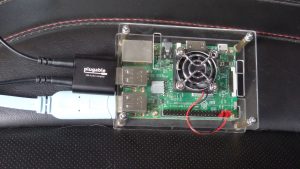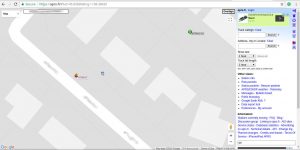Mobile Digipeating: Increasing APRS Reception While Backpacking (2 of 2)
<– If you haven’t read part 1, click here to read Mobile Digipeating: Increasing APRS Reception While Backpacking (1 of 2)
A computer with a sound card interfaces to your radio via two 3.5 mm audio cables. An interface cable will be required for this, which you can either make yourself or order one from Clifford Wareham (https://www.ebay.com/usr/cliffordwareham?_trksid=p2047675.l2559). Once you have your interface, you will need to determine what hardware (computer) and what software (the APRS digipeating software) you will use. For my setup, I went with a Raspberry Pi 3– a well documented and reliable miniature computer that runs Linux. The Raspberry Pi 3 does need a USB sound card in order to work as a digipeater, since the Pi only natively supports audio out. The Pi 3 and a USB sound card should cost no more than $50.
The Raspberry Pi ships without an operating system, but you can download the Raspbian Linux distribution from https://www.raspberrypi.org/downloads/raspbian/. The documentation on raspberrypi.org is excellent and will help you install the operating system on a micro SD card. I recommend installing the “Raspbian Lite” version since your digipeater will ideally run without a monitor. If you are new to Linux, you may find the “Raspbian Desktop” version easier to use. Once you have your operating system installed, now you will need to install Direwolf, the APRS digipeating software.
In an effort to not reinvent the wheel, there is already an excellent tutorial on setting up Direwolf on a Raspberry Pi. The tutorial is located at https://github.com/wb2osz/direwolf/blob/master/doc/Raspberry-Pi-APRS.pdf and is quite detailed, at 34 pages long. If you plan on using Clifford Wareham’s interface cable, make sure the following line is present in your Direwolf configuration, to trigger PTT properly:
ptt /dev/ttyS0 DTR RTS
In addition, you will want to setup Direwolf to run at system startup. This is covered in section 6.1 of the Direwolf tutorial linked above, and will be necessary for your setup. The last consideration for your Pi is power- the Pi 3 pulls an average of .5 amps at 5v, making it use approximately .25 amps per hour (known as Amp Hours, or AH) on your marine battery. Assuming that you’re backpacking for two days, this is only a 12 AH drain. Most marine batteries are 80-100 AH, so this leaves plenty of power for your radio to transmit with (and it will need it- a 50-watt radio uses approximately 4AH while transmitting). Purchase a cigarette socket adapter for your 12-volt battery, connect it to your battery, and then plug a USB charger into the cigarette socket. When you’re ready to start up your APRS digipeater, plug in your Raspberry Pi, and then turn on your radio.
Once you have your radio, antenna, and Raspberry Pi working together, it’s time to test your setup. You can do this by running Direwolf in interactive mode, or by letting it run at startup (and configuring Direwolf to log all activity to a log file). It’s easier to run Direwolf in interactive mode, simply because you will see packets that Direwolf detects in real-time. Once Direwolf has started, it will send a beacon packet out. Your radio’s PTT should be triggered at this time, and then released once the packet has been sent. If you transmit an APRS message using your handheld, you should also see Direwolf detect the packet, and then re-transmit it a second or two later. If your setup is a success, you should see both your digipeater and your handheld show up on https://aprs.fi/.
One word of caution with setting up an APRS digipeater is that you should only be operating this setup in an area that does not already have a digipeater nearby. Check https://aprs.fi before you leave for the trailhead, you may be surprised to see an igate or digipeater already within range. When testing your setup at home, make sure to transmit on the lowest power possible- 50 watts is far too powerful to be used in most urban environments, and can “talk over” other stations trying to use APRS. Other than that word of caution, have fun with your new digipeating system, and enjoy the ability to send your loved ones text messages or APRS messages while backpacking.


